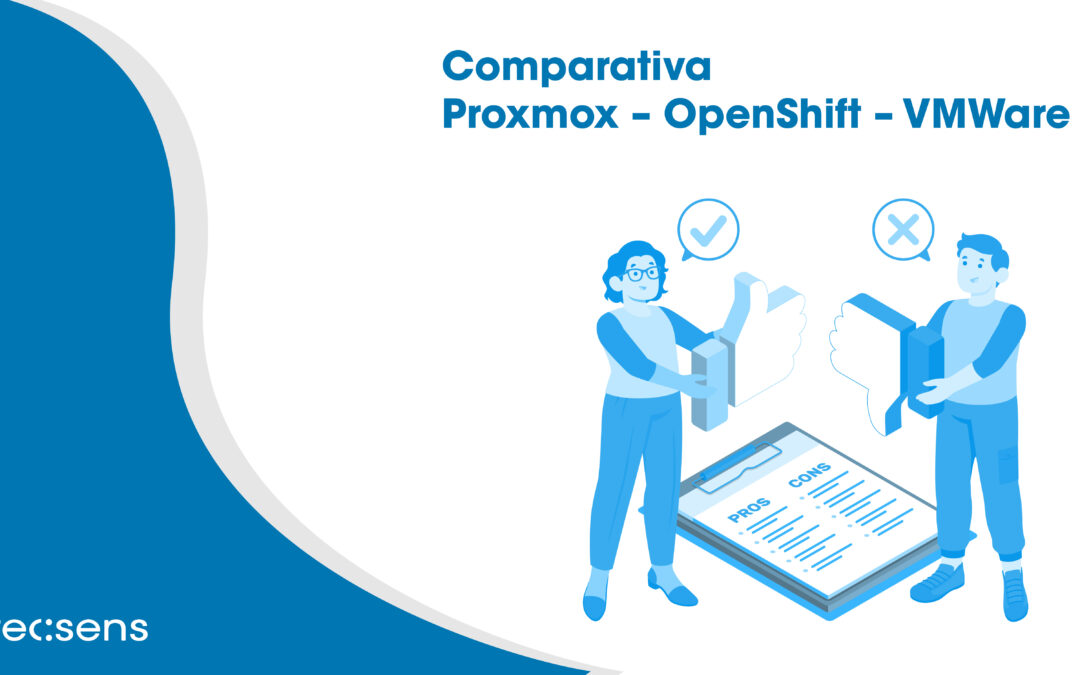Managing and orchestrating containers and virtual machines is a critical aspect of modern IT infrastructure. Three of the most prominent platforms in this area are Proxmox, OpenShift, and VMware. Each of them has its own strengths and weaknesses that make them better suited for different types of deployments and business needs. Below is a detailed Proxmox – OpenShift – VMWare comparison of these three solutions.
Proxmox
Proxmox Virtual Environment (PVE) is an open-source platform that combines KVM-based virtualization and container management with LXC (Linux Containers). Proxmox is known for its ease of use and the integration of multiple virtualization technologies into a single solution.
Ease of Use: Proxmox stands out for its intuitive web interface that allows administrators to manage both virtual machines and containers efficiently. The simplicity of its installation and configuration is one of its main advantages.
Cost: Being an open-source solution, Proxmox is free, although it offers commercial subscriptions for professional support.
Characteristics: It includes a wide range of built-in tools such as backups, snapshots, high availability, and a firewall. Its support for Ceph and ZFS provides advanced storage options.
Use Cases: Ideal for small and medium-sized businesses that need a robust and cost-effective virtualization solution.
OpenShift
OpenShift is a Kubernetes container platform developed by Red Hat, which makes it easy to manage containerized applications. It focuses on offering a complete solution for the development, deployment, and management of containerized applications.
Ease of Use: OpenShift offers a powerful web UI and command line, but it can have a steep learning curve due to its inherent complexity and the advanced capabilities it offers.
Cost: OpenShift has a free version (OKD – Origin Kubernetes Distribution) and several commercial versions that include additional support and functionalities.
Characteristics: It integrates CI/CD (Continuous Integration/Continuous Deployment) tools, security policy management, autoscaling, and a robust ecosystem for developers. Its integration with Red Hat Enterprise Linux (RHEL) ensures a high level of security and performance.
Use Cases: It is ideal for large enterprises and organizations that need a scalable and highly automated container solution.
VMware
VMware is a pioneer in virtualization and offers a full range of products including VMware vSphere for server virtualization and VMware Tanzu for container management.
Ease of Use: VMware is known for its well-designed user interface and polished user experience. Although its initial setup can be complex, the platform offers extensive documentation and professional support.
Cost: VMware is a commercial solution, and its costs can be high, especially for large environments. However, it offers significant value through its reliability and advanced features.
Features: VMware vSphere provides advanced features such as vMotion (hot migration of virtual machines), DRS (Distributed Resource Scheduler), and high availability. VMware Tanzu enables large-scale Kubernetes management, integrating with existing VMware environments.
Use Cases: It is ideal for large enterprises and organizations that require a mature and reliable virtualization solution with commercial support.
Proxmox – OpenShift – VMWare Comparison and Conclusion
Ease of Use: Proxmox is the simplest to use and configure, followed by VMware, which offers a highly refined user experience, while OpenShift can be more complex due to its focus on containers and Kubernetes.
Cost: Proxmox is the cheapest option due to its open-source nature. OpenShift and VMware have significant associated costs, especially in their commercial versions.
Characteristics: VMware and OpenShift stand out for their advanced features and enterprise support, while Proxmox offers a robust solution with a great balance of functionality for its cost.
Use Cases: Proxmox is ideal for SMEs looking for an economical and effective solution. OpenShift is perfect for large enterprises focused on DevOps and containers. VMware is the preferred choice for enterprise environments that require high reliability and advanced virtualization features.
In summary, the choice between Proxmox, OpenShift, and VMware will depend on the specific needs of the organization, the budget available, and the desired approach to virtualization and container management. Each platform offers a unique set of benefits that can be decisive depending on the context in which they are deployed.




